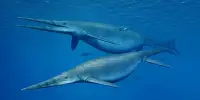Otodus megalodon, often known as the megalodon or megatooth shark, was a powerful animal that formerly swam in the ancient waters. They could grow to a massive 16 meters, making them bigger than any other predatory sharks at the time (52 feet). In contrast, female whale sharks, which average 4.5 meters in length, are the largest predatory fish in the ocean right now (15 feet). The megalodon fell extinct 3.6 million years ago, which was unfortunate for them (but fortunate for many marine species). Scientists have discovered that the megalodon was the highest-level trophic level ocean predator, alive or extinct, according to a recent research published in Science Advances.
But why is it crucial to know the trophic level of extinct animals? “Trophic level is a key property of creatures; figuring out the trophic level of ancient species may teach us about their role in the ecosystem, and it may even help us understand the evolution and extinction of particular animals,” according to the World Wildlife Fund. IFLScience was informed by the study’s principal author, Dr. Emma Kast.
Determining the trophic level of extinct creatures can also aid in our understanding of the ecology of ancient ecosystems on a more general level. For instance, the megalodon’s extremely high trophic level may suggest that food chains were longer millions of years ago. How and why could this former ecology support a predator at such a high trophic level? These are intriguing inquiries that we may begin to address. The trophic level of the megalodon could not be identified since it has historically been challenging for scientists to use methodologies for extant animals to identify the trophic level of long-extinct species. That is, prior to this investigation.
Because animals need nitrogen in their diets, it is common practice to utilize the nitrogen isotope composition of animal tissues to determine the trophic levels in contemporary ecosystems. Because animals at higher trophic levels obtain more nitrogen-15 from their diet, the ratio of nitrogen-15 (d15N) to nitrogen-14 (d14N) can be used to identify trophic levels. “Only during the last 10,000–100,000 years have nitrogen isotopes been utilized on ancient sea species. One such is the discovery of a modern-looking Arctic food web structure by Feranec et al. in 2021, who measured the d15N of ancient bone collagen that was around 12,000 years old. Tells IFLScience, Kast.
“Collagen is often not retained beyond these durations. We focused on the organic material found inside biominerals rather than collagen since it can be kept over a much longer period of time. In addition to being the first time we have been able to employ d15N to rebuild the trophic level of a marine animal lover million-year timeframes, our work is also the first to use the enameloid-bound organic matter d15N technique to ancient sharks. The ratio found using this method in ancient megalodon teeth was significantly greater than those found in orcas, contemporary white sharks, and polar bears.
The information suggested that the marine food chains during the Cenozoic epoch were two stages longer than they are now. The megalodon could have consumed nursing mammal calves and even tiny megalodon sharks. The scientists’ analysis of the various tooth samples revealed a broad range of nitrogen levels, indicating that not every huge animal was at the top of the food chain.
This team is preparing to do fascinating research. There is still a ton of fascinating work to be done. On the one hand, there is still much to discover about the megalodon; for instance, in this study we only examined adult teeth, but we would be curious to know if the juveniles had a totally different diet, similar to the modern white shark. To further our knowledge of ancient feeding webs, we are eager to apply this sort of mineral-bound d15N method to additional fossilized species. Tells IFLScience, Kast.














